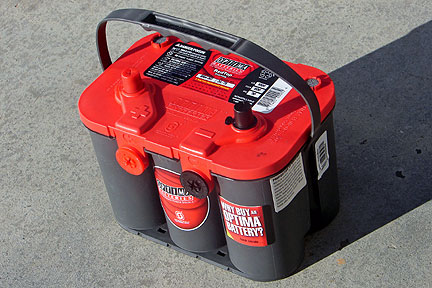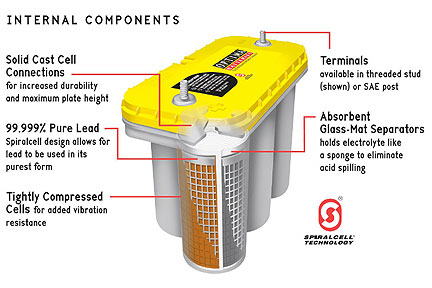Does your vehicle's battery live a tough life? Lots of vibration, high under-hood temperatures or maybe sitting idle for months? Does it have to crank over a diesel engine in very cold weather. Maybe, it has to power lots of electrical accessories, lights, or a high-performance sound system. If so, you might consider an OPTIMA(R) battery.

|
| OPTIMA RedTop battery. |
The OPTIMA battery's unique Spiralcell design makes it quite different from the traditional lead-acid battery. Ordinary lead-acid batteries use flat lead plates whereas the Spiraldesign features two thin lead plates tightly wound into a spiral cell. Absorbent glass mat (AGM) separators between the wound plates contains the electrolyte held like a sponge to preclude any chance of acid spillage. The cells are surrounded by durable and weather resistant plastic, and completely welded together. Immobilized, locked in place plates means improved vibration resistance. According to company, the OPTIMA battery is more than 15 times more resistant to vibration than other batteries.
The thin lead plates provide more lead surface area than in traditional lead/acid batteries for faster recharging. Also the spiral design allows lead to be used in its purest (99.999% pure) form. The design minimizes resistance and gives even pressure over the entire lead surface, providing fast energy availability and an extra long life span. In a traditional flooded or wet cell battery heat can cause increased acid density due to gassing that shortens battery life. Furthermore, since there is no shedding of active paste material, there is no gradual loss of power and capacity as the battery ages. The company says the OPTIMA(R) has twice the life expectancy compared to regular batteries.
More plate surface, closer plate spacing, ability to use high purity lead result in low internal resistance. This low resistance gives you more power in a smaller box, ability to recharge much faster, higher, cleaner voltage characteristics during discharge.

|
| Internal Details of OPTIMA Battery. |
Some of the alloys in conventional batteries are more prone to electron transfer resulting in self discharge than the materials used in the OPTIMA(R). Their low rate of self discharge guarantees plenty of starting power even after long periods of storage. The low rate of self-discharge means they can go unused for up to one year without recharging if kept at, or below, room temperature. And because of its low internal resistance, they recharge faster. In testing, OPTIMA(R) batteries have have started large diesel engines in outdoor temperatures down to -40-degrees F.
The technique of winding the cells, which are linked with solid connections, gives maximum performance with a minimum of size and weight. This makes the battery compact, robust and easy to mount. Indeed, it can be mounted in virtually any angle, even on its side. Because acid cannot leak or spill, they are clean, plus user-and environmentally-friendly. The completely maintenance free sealed case design eliminates the need to add water or clean terminals. Indeed, corrosion cannot form around the posts.
Loss of water which can lead to plate dry out and failure cannot happen with an OPTIMA(R) battery.
The OPTIMA batteries come in three series. The OPTIMA RedTop is designed for SLI (starting, lighting and ignition applications) and should not be used for deep cycle applications. The OPTIMA YellowTop is a dual mode battery for both SLI and deep cycle service. The BlueTop batteries, designed specifically for marine applications, come in SLI and dual mode versions. Incidentally, OPTIMA deep cycle batteries use a different chemistry for the active paste material on the plates, and a slightly stronger acid. This chemistry change allows for a much longer life in deep cycling applications with only a slight reduction in power output.
Like any lead-acid battery, the OPTIMA battery can be connected to any type charger, including solar chargers, as long as the voltage is regulated properly.




